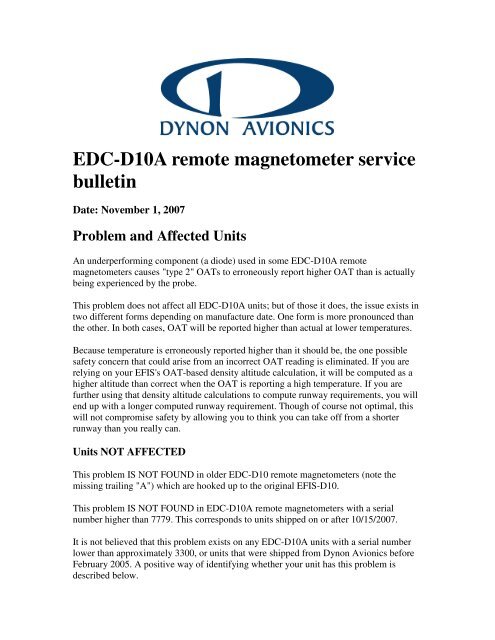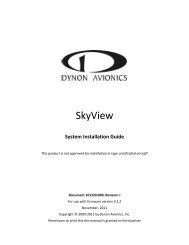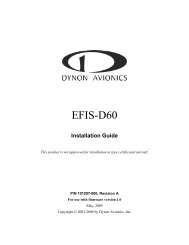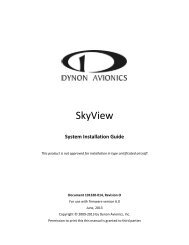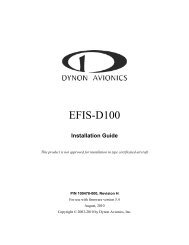Download - Dynon Avionics
Download - Dynon Avionics
Download - Dynon Avionics
Create successful ePaper yourself
Turn your PDF publications into a flip-book with our unique Google optimized e-Paper software.
EDC-D10A remote magnetometer servicebulletinDate: November 1, 2007Problem and Affected UnitsAn underperforming component (a diode) used in some EDC-D10A remotemagnetometers causes "type 2" OATs to erroneously report higher OAT than is actuallybeing experienced by the probe.This problem does not affect all EDC-D10A units; but of those it does, the issue exists intwo different forms depending on manufacture date. One form is more pronounced thanthe other. In both cases, OAT will be reported higher than actual at lower temperatures.Because temperature is erroneously reported higher than it should be, the one possiblesafety concern that could arise from an incorrect OAT reading is eliminated. If you arerelying on your EFIS's OAT-based density altitude calculation, it will be computed as ahigher altitude than correct when the OAT is reporting a high temperature. If you arefurther using that density altitude calculations to compute runway requirements, you willend up with a longer computed runway requirement. Though of course not optimal, thiswill not compromise safety by allowing you to think you can take off from a shorterrunway than you really can.Units NOT AFFECTEDThis problem IS NOT FOUND in older EDC-D10 remote magnetometers (note themissing trailing "A") which are hooked up to the original EFIS-D10.This problem IS NOT FOUND in EDC-D10A remote magnetometers with a serialnumber higher than 7779. This corresponds to units shipped on or after 10/15/2007.It is not believed that this problem exists on any EDC-D10A units with a serial numberlower than approximately 3300, or units that were shipped from <strong>Dynon</strong> <strong>Avionics</strong> beforeFebruary 2005. A positive way of identifying whether your unit has this problem isdescribed below.
Though your EDC-D10A may have the bad component, this problem WILL NOTAFFECT you if you do not have a "type 2" OAT hooked up to your EDC-D10A. ThisOAT is sold under part number 100433-001. It is identifiable by a small piece of blackheat shrink tubing around the wires near the sensor end of the probe.Affected Units and Symptom CharacterizationEDC-D10A units sold between approximately February 2005 and April 2007, with serialnumbers between approximately 3300 and 6700:• Below -10 degrees Fahrenheit, the OAT displayed will be higher than the actualOAT.EDC-D10A units sold between approximately April 2007 and October 15, 2007, withserial numbers between approximately 6700 and 7779:• Below 40 degrees Fahrenheit, the OAT displayed will be higher than the actualOAT.Note that in both of the above cases, the displayed temperature WILL continue todecrease, albeit incorrectly, as the actual OAT decreases.If your EDC-D10A is in either of the above ranges, but has a "D3" marking (eitherlabeled or handwritten), your EDC-D10A has already been fixed and needs no furtherwork.Additional Verification that your EDC-D10A is AffectedIn addition to verifying via comparison with the serial number ranges above, you mayopen your EDC-D10A to authoritatively check whether or not your magnetometer isamong those affected. This action will not void your warranty. You may also choose tosend your unit in based solely on the serial number checks described above.The EDC-D10A can be opened by removing the four brass screws on the sides of theshell. The cover of the EDC-D10A with the serial number can then be removed by liftingit straight up.Once open, look for the small black component in the picture below. If that component isthere, it needs to be removed, either by you or by <strong>Dynon</strong> <strong>Avionics</strong>. If the space is blank,your EDC-D10A does not suffer from this problem. Also note that your circuit boardcolor may vary. The presence of this component is the sole definitive indicator ofwhether or not your unit is affected.
SolutionsThere are two ways to solve this issue.If you own an EMS product or a FlightDEK-D180, you can move your 3 wire type 2OAT from your EDC, to a spare EMS GP input as described in the installation manual.Alternately, you can fix your EDC-D10A, either yourself or by sending it to <strong>Dynon</strong><strong>Avionics</strong> as described below.Fixing your EDC-D10AIf your EDC-D10A is affected as above, you have two options.Option 1: Return your EDC-D10A to <strong>Dynon</strong> <strong>Avionics</strong>:Unlike other support issues, we do not require return authorization for this problem.Simply send your affected EDC-D10A to<strong>Dynon</strong> <strong>Avionics</strong>19825 141st Pl NEWoodinville, WA 98072Clearly label the package you send with the words "EDC RECALL"Enclose a letter with your return shipping address. <strong>Dynon</strong> <strong>Avionics</strong> will cover the cost ofshipping your EDC-D10A back to you.Option 2: Fix it Yourself:You may elect to try to fix this issue yourself, per the instructions below. This action willnot void your warranty, and it is exactly the same fix as we perform here if you elect tosend it in. If you inadvertently damage your EDC-D10A while trying to fix it, you maysend it in per the above instructions and <strong>Dynon</strong> <strong>Avionics</strong> will still fix it under warranty.The component highlighted in the picture below is the one to be removed. Fortunately, itis not needed for correct operation of the EDC-D10A or OAT.Before beginning work on your EDC-D10A, make sure you take the appropriate steps toeliminate damage from ESD (electrostatic discharge). The easiest way to do this is tomake sure you have continuous contact with the EDC-D10A's chassis. Additionally,make sure you touch the chassis before anything on the circuit board. For more detailabout taking precautions against ESD, seehttp://ecmweb.com/mag/electric_electrostatic_discharge_causes/
The easiest way to remove the component is to use a pair of precision wire cutters ordikes to cut it out. Desoldering the component is acceptable as well, but is harder to do onsuch a small scale.Instead of trying to clip the leads directly, we have found it easier to start by cutting rightdown the middle of the black center portion of the diode itself. After it has shattered, usethe cutters to clean up the area so that there are no remnant of the component remaining.In particular, there should be no remaining protrusions or leads that should be able totouch each other. The area should be essentially bare when you are finished. Clear outany remaining debris and ensure that all remnants are outside of the enclosure.After you've removed the component and have the EDC-D10A put back together, pleaseclearly mark the EDC-D10A with the label "D3". This will let any future owner of yourEDC-D10A know that it has been fixed.
EDC-D10A with bad component
EDC-D10A after malfunctioning component is removed


